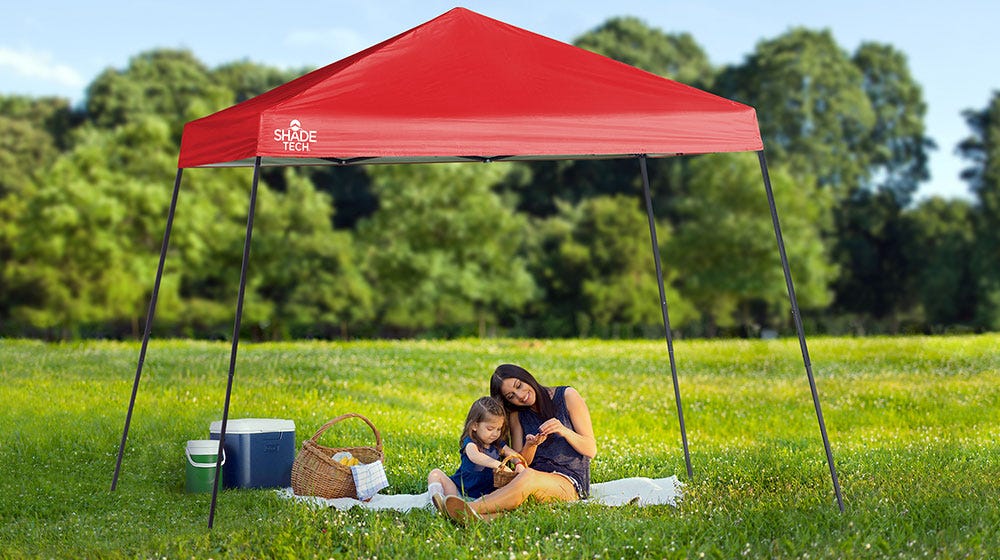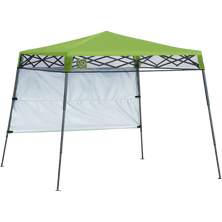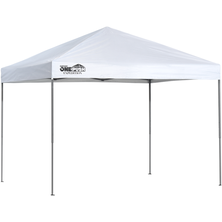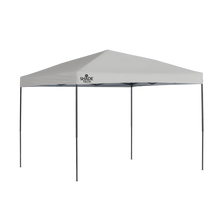So, you've decided that you need a pop-up canopy tent in your life. When choosing such a canopy, one of the biggest decisions you'll have to make is whether to get a straight-leg one or a slant-leg one.
Each one is suited to different conditions, so it really depends on your circumstances as to which one you should get. Are you looking for strength over weight, or durability over price? Are you going to be in wet or dry conditions? These are important questions that you need to ask yourself before investing in a pop-up tent.
In this article, we talk about the differences between the two options and how you can choose the best one for your needs.
First up, let's clarify exactly what a pop-up canopy tent is.
What Is a Pop-Up Canopy Tent?
A pop-up canopy tent is a type of portable shelter that's made up of an aluminum or steel frame that supports a fabric roof. The frame is usually collapsible, which makes the whole structure easy to transport and set up.
Pop-up canopy tents come in all sorts of shapes and sizes, but they typically have one thing in common: they're all designed to provide temporary protection from the elements, whether it's the sun, rain, or snow.
There are all sorts of reasons why you might need a pop-up canopy tent. Perhaps you're planning a weekend camping trip and want a little extra shelter for your gear. Or maybe you need a shady spot to relax in during a summer music festival. Whatever the reason, a pop-up canopy tent can come in handy.
When shopping for a pop-up canopy tent, there are a few things to keep in mind. First, think about how much space you'll need. Canopy tents come in a variety of sizes, so it's important to choose one that's big enough to accommodate your needs. Second, consider the weight and portability of the tent. If you plan on traveling with your tent, you'll want to make sure it's not too heavy or bulky to carry. Finally, take a look at the materials used to construct the canopy. The frame should be made of durable materials like aluminum or steel, and the fabric roof should be made of waterproof and UV-resistant material.
With so many different types of pop-up canopy tents on the market, it can be tough to choose the right one for your needs. But if you keep these factors in mind, you'll be sure to find the perfect canopy tent for your next outdoor adventure.
Now, let's take a look at the differences between a straight-leg and a slant-leg pop-up canopy tent.
Straight-leg canopy tent
A straight-leg canopy tent is a type of canopy tent that has straight legs, as opposed to the more common angled legs. This makes them more stable and easier to set up, but they are also more expensive.
These tents are ideal for events that require a lot of space, such as weddings or large parties. They are also great for providing shelter during outdoor activities like camping or picnicking.
When choosing a straight-leg canopy tent, it is important to consider the size and capacity that you need. You should also think about the type of event that you will be using it for. If you need a large tent for a wedding or party, then you should choose one with a bigger capacity. If you just need a small tent for camping or picnicking, then you can save money by choosing a smaller size.
Choosing the right option
There are a few things to consider before purchasing a straight-leg canopy tent. First, decide if you need the extra height that a straight-leg tent provides. If you frequently camp in areas with tall trees or uneven terrain, the extra height can be useful. However, keep in mind that straight-leg tents are more difficult to set up than traditional dome tents.
Another thing to consider is wind resistance. Straight-leg canopy tents are more resistant to strong winds than dome tents. This is due to the fact that they have fewer sides and a lower center of gravity. However, they can still be toppled in high winds if not properly anchored.
Straight-leg canopy tents are available in a variety of sizes and styles. Some have more features than others, such as windows or screened doors. The more features a tent has, the more expensive it will be.


Slant-leg pop-up canopy tent
A slant-leg pop-up canopy tent is a type of portable shelter that consists of a steel or aluminum frame that supports a fabric canopy. The frame is typically composed of four telescoping legs that can be adjusted to create a peaked or slanted roofline. The fabric canopy is attached to the frame with hooks, loops, or clips and can be made from a variety of materials such as polyester, nylon, or canvas.
Canopy tents with slant-legs are popular for a variety of outdoor events such as tailgating parties, picnics, camping trips, and fairs or markets. They provide protection from the sun and rain and can be easily set up and taken down. Some models come equipped with additional features such as mosquito netting, storage pockets, or UV-resistant coatings.
The main difference between a slant-leg pop-up canopy tent and a straight-leg canopy tent is the angle of the legs. Slant-leg tents have legs that angle outwards from the center of the frame, while straight-leg tents have legs that are perpendicular to the frame. This gives slant-leg tents a lower profile and makes them more stable in windy conditions.


Should I Choose an Aluminum Frame or a Steel Frame for my pop-up canopy tent?
There are a few things to consider when deciding between an aluminum or steel frame for your pop-up canopy tent. Aluminum frames are typically lighter in weight than their steel counterparts, making them easier to transport and set up. Steel frames, on the other hand, tend to be more durable and sturdy, making them ideal for use in windy conditions or on uneven terrain.
Let's take a look at each option.
Aluminum Frame
There are a few positives and negatives with aluminum-framed pop-up canopy tents.
Pros
- The lighter weight makes it easier to set up and transport: This is probably the biggest advantage of an aluminum frame. If you're going to be setting up and taking down your tent regularly, or if you'll be transporting it any distance, the lighter weight of an aluminum frame will be a big plus.
- Less expensive: Aluminum frames are usually less expensive than steel frames, making them a budget-friendly option.
Cons
- Not as durable as steel: One downside of aluminum is that it's not as durable as steel. If you're expecting windy conditions or if you'll be using your tent on rough terrain, a steel frame might be a better choice.
- Can bend: Another potential downside of aluminum is that it can bend more easily than steel. So if you're expecting high winds or if your tent will be subject to a lot of movement, steel might be a better option.
Steel Frame
Let's take a look at some of the pros and cons of steel-framed pop-up canopy tents.
Pros
- More durable: The biggest advantage of a steel frame is that it's more durable than an aluminum frame. If you're expecting windy conditions or if you'll be using your tent on rough terrain, a steel frame is a better choice.
- Won't bend: Another advantage of steel is that it won't bend as easily as aluminum. So if you're expecting high winds or if your tent will be subject to a lot of movement, steel is a better option.
Cons
- Heavier weight: The biggest downside of a steel frame is that it's heavier than an aluminum frame. If you'll be setting up and taking down your tent regularly, or if you'll be transporting it any distance, the extra weight can be a drawback.
- More expensive: Steel frames are usually more expensive than aluminum frames, making them less budget friendly.
So, which option is right for you? It really depends on your needs. If you need a durable tent for windy conditions or rough terrain, a steel frame is a good choice. If you need a lighter-weight tent that's easier to set up and transport, an aluminum frame might be a better option. And if you're on a budget, aluminum is usually the less expensive choice.
Tips on setting up a pop-up canopy tent
Here are a few tips to help you set up your pop-up canopy tent:
- Read the instructions carefully before beginning to set up the tent. This will help you familiarize yourself with the process and avoid any mistakes.
- Make sure that all of the poles are the same length before inserting them into the ground. Otherwise, the tent will be uneven and unsteady.
- Use a mallet or hammer to drive the stakes into the ground. This will help ensure that they are firmly in place.
- If you are setting up the tent in an area with tall grass or weeds, make sure to clear the area beforehand. Otherwise, the fabric of the tent can become snagged on the vegetation.
- Be sure to guy out the corners of the tent using ropes or cords. This will help keep the tent stable in windy conditions.
With these tips in mind, you'll be able to set up your straight-leg canopy tent with ease. Happy camping!
Which Should You Choose?
When deciding which option is best for you, consider your needs and the conditions in which you'll be using your tent. Each tent is suited to different conditions, needs, and budgets.
We hope this article has helped you decide whether you need a straight-leg or a slant-leg pop-up canopy.




